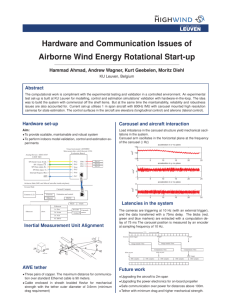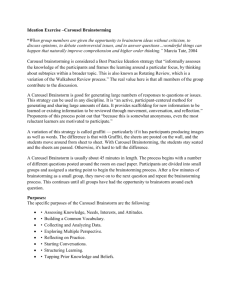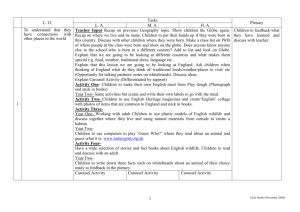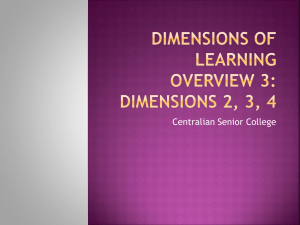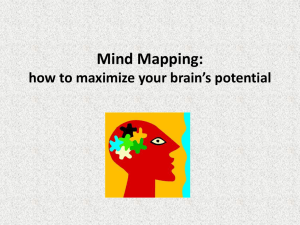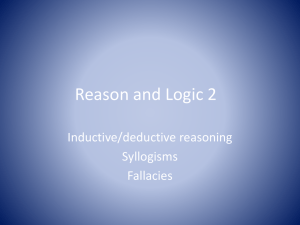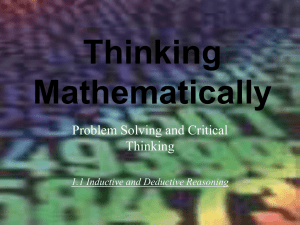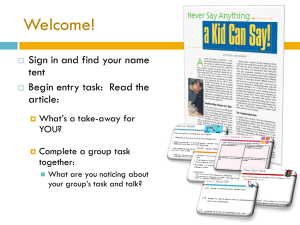Extended thinking refresher
advertisement
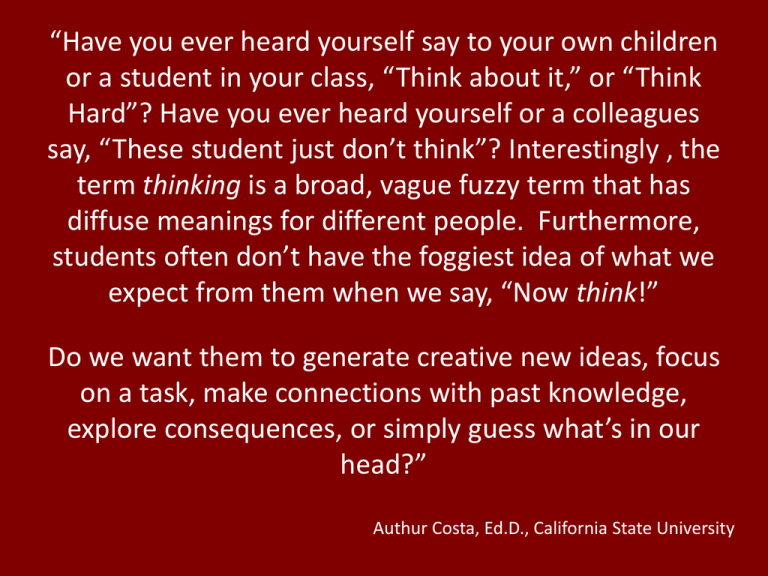
“Have you ever heard yourself say to your own children or a student in your class, “Think about it,” or “Think Hard”? Have you ever heard yourself or a colleagues say, “These student just don’t think”? Interestingly , the term thinking is a broad, vague fuzzy term that has diffuse meanings for different people. Furthermore, students often don’t have the foggiest idea of what we expect from them when we say, “Now think!” Do we want them to generate creative new ideas, focus on a task, make connections with past knowledge, explore consequences, or simply guess what’s in our head?” Authur Costa, Ed.D., California State University Welcome! Please respect the prevailing MASD professional development norms – Silence and put away handheld electronic devices – Consider how new ideas can be incorporated into your teaching – Be critical of ideas, not people – Ask questions as they arise – Use post-its and annotations on today’s materials to help you revisit today’s learnings Extended thinking refresher Ideas and examples from across the curriculum EQ: How can extended thinking strategies be used, in all of our classrooms, to enhance student learning? Key Learnings: – Each of the eight extended thinking strategies can be used within each of the disciplines we teach – The eight extended thinking strategies can be used flexibly throughout the diversity of unit and lesson components – There is a strong connection between the RWSL standards and the eight extended thinking skills Vignette: The Red Ball “Imagine for a moment that you are driving down a street in residential neighborhood, heading home. Your speed is constant. Music from the radio washes in and out of hearing. But please don’t – step on my blue suede shoes… Suddenly, your heads snaps to the left – a red blur, in motion, uneven trajectory. Eyes focus. Red ball. Bouncing. Up down knee jerk. Foot to brake pedal, softly first. Scan again, behind bushes. Focus. Eyes fix on running child. Boy, six years. Hit the brakes! Hammer down right knee. Lock brakes. Tires shriek, drifting right. Adjust wheel to fit drift. Steady the slide. Boy, bent to ball, looks up. You watch boy startle at sudden shriek, eyes like two round questions, flashing quickly to the left. No thud. Passed. Done. Your knee lets up. The force you bring to the pedal decreases. As your brakes unlock, the wheels track again. You center the car in the road. Through the mirror over the dashboard, you watch the boy, now appearing to be seven or eight years old, retrieve his ball from the gutter and run back again to the game in his front yard. Your foot returns pressure to the gas pedal. And the radio plays again. You can do anything but lay off my blue suede shoes… A representative of the Vermont State Police has assured me that this entire episode could transpire in less than four seconds.” Clarke, Patterns of Thinking Vignette: The Red Ball 1. 2. 3. 4. 5. 6. 7. 8. Road Radio Red ball Boy Breaking Skidding Radio Road 1. 2. 3. 4. 5. 6. 7. 8. ? Comparing / Contrasting Classifying / Categorizing Inductive reasoning Deductive reasoning Error analysis Analyzing perspectives ? Vignette: The Red Ball • The easy part is that we are all born with an inherent tendency toward these thinking skills. • The hard part is harnessing them to promote learning • The exciting part is seeing how the application of these thinking skills to our lessons reinforces what we teach. • Remember, Marzano determined a 45 point effect size when extended thinking skills were used! When planning for Extended thinking, the EATS, EMTS and EATES lesson formats are a little confining. • EATS: EQ, Activation, Teaching Strategies, Summarizing • EMTS: EQ, Mini-lesson, Task, Sharing • EATES: EQ, Activation, Teaching Strategies, Extended thinking, Summarizing The truth is, Extended thinking skills should be used during… • • • • • Unit Launch Activation Teaching / Formative assessment Summarizing Culminating activities / Summative assessment Note how today’s examples are distributed throughout the various components of lesson and unit plans. Students are extending thinking when they… • • • • • • • • Find patterns Look at something from multiple perspectives Categorize information in multiple ways Compare and contrast information to other content Explain the importance of information Draw conclusions from information Analyze errors in information Use the information to make predictions Carousel brainstorming KWL Abstracting Error Analysis 7 minutes per round Comp/Contrast Classify/Cat Summarizing! How will you remember it? Extended Thinking: Abstracting _____________ Carousel #1 • • • • Abstracting Deductive Reasoning Inductive Reasoning Error Analysis Once we begin, the presentation will auto-run through the cycle, so don’t get bogged down too much at any one point! What do you KNOW? 0 0 0 56 021345 9876543210 Hours Minutes Seconds What do you WANT to know? 0 0 0 45 021345 9876543210 Hours Minutes Seconds What have you LEARNED? 0 0 0 34 021345 9876543210 Hours Minutes Seconds What have you LEARNED? 0 0 0 23 021345 9876543210 Hours Minutes Seconds What have you LEARNED? 0 0 0 12 021345 9876543210 Hours Minutes Seconds Where can you USE IT? 0 0 0 01 021345 9876543210 Hours Minutes Seconds Please close your Strategy folder, pass it clockwise around the table and begin your next round of Carousel Brainstorming! Don’t forget, we’ll have time to share at the end of the first Carousel rotation. What do you KNOW? 0 0 0 56 021345 9876543210 Hours Minutes Seconds What do you WANT to know? 0 0 0 45 021345 9876543210 Hours Minutes Seconds What have you LEARNED? 0 0 0 34 021345 9876543210 Hours Minutes Seconds What have you LEARNED? 0 0 0 23 021345 9876543210 Hours Minutes Seconds What have you LEARNED? 0 0 0 12 021345 9876543210 Hours Minutes Seconds Where can you USE IT? 0 0 0 01 021345 9876543210 Hours Minutes Seconds Please close your Strategy folder, pass it clockwise around the table and begin your next round of Carousel Brainstorming! Don’t forget, we’ll have time to share at the end of the first Carousel rotation. What do you KNOW? 0 0 0 56 021345 9876543210 Hours Minutes Seconds What do you WANT to know? 0 0 0 45 021345 9876543210 Hours Minutes Seconds What have you LEARNED? 0 0 0 34 021345 9876543210 Hours Minutes Seconds What have you LEARNED? 0 0 0 23 021345 9876543210 Hours Minutes Seconds What have you LEARNED? 0 0 0 12 021345 9876543210 Hours Minutes Seconds Where can you USE IT? 0 0 0 01 021345 9876543210 Hours Minutes Seconds Please close your Strategy folder, pass it clockwise around the table and begin your next round of Carousel Brainstorming! Don’t forget, we’ll have time to share at the end of the first Carousel rotation. What do you KNOW? 0 0 0 56 021345 9876543210 Hours Minutes Seconds What do you WANT to know? 0 0 0 45 021345 9876543210 Hours Minutes Seconds What have you LEARNED? 0 0 0 34 021345 9876543210 Hours Minutes Seconds What have you LEARNED? 0 0 0 23 021345 9876543210 Hours Minutes Seconds What have you LEARNED? 0 0 0 12 021345 9876543210 Hours Minutes Seconds Where can you USE IT? 0 0 0 01 021345 9876543210 Hours Minutes Seconds This concludes the first round of Carousel BrainstormingNow it’s time to share! Carousel #1 Extended thinking strategies Examples • Abstracting • A Database is like a… (Fourbox Synectics) • Deductive Reasoning • Gender of nouns in Spanish • Inductive Reasoning • What’s in store for our stores? • Error Analysis • Paging Mr. Ponzi Carousel #2 • • • • Analyzing Perspectives Classifying and Categorizing Compare / Contrast Constructing Support What do you KNOW? 0 0 0 56 021345 9876543210 Hours Minutes Seconds What do you WANT to know? 0 0 0 45 021345 9876543210 Hours Minutes Seconds What have you LEARNED? 0 0 0 34 021345 9876543210 Hours Minutes Seconds What have you LEARNED? 0 0 0 23 021345 9876543210 Hours Minutes Seconds What have you LEARNED? 0 0 0 12 021345 9876543210 Hours Minutes Seconds Where can you USE IT? 0 0 0 01 021345 9876543210 Hours Minutes Seconds Please close your Strategy folder, pass it clockwise around the table and begin your next round of Carousel Brainstorming! Don’t forget, we’ll have time to share at the end of the first Carousel rotation. What do you KNOW? 0 0 0 56 021345 9876543210 Hours Minutes Seconds What do you WANT to know? 0 0 0 45 021345 9876543210 Hours Minutes Seconds What have you LEARNED? 0 0 0 34 021345 9876543210 Hours Minutes Seconds What have you LEARNED? 0 0 0 23 021345 9876543210 Hours Minutes Seconds What have you LEARNED? 0 0 0 12 021345 9876543210 Hours Minutes Seconds Where can you USE IT? 0 0 0 01 021345 9876543210 Hours Minutes Seconds Please close your Strategy folder, pass it clockwise around the table and begin your next round of Carousel Brainstorming! Don’t forget, we’ll have time to share at the end of the first Carousel rotation. What do you KNOW? 0 0 0 56 021345 9876543210 Hours Minutes Seconds What do you WANT to know? 0 0 0 45 021345 9876543210 Hours Minutes Seconds What have you LEARNED? 0 0 0 34 021345 9876543210 Hours Minutes Seconds What have you LEARNED? 0 0 0 23 021345 9876543210 Hours Minutes Seconds What have you LEARNED? 0 0 0 12 021345 9876543210 Hours Minutes Seconds Where can you USE IT? 0 0 0 01 021345 9876543210 Hours Minutes Seconds Please close your Strategy folder, pass it clockwise around the table and begin your next round of Carousel Brainstorming! Don’t forget, we’ll have time to share at the end of the first Carousel rotation. What do you KNOW? 0 0 0 56 021345 9876543210 Hours Minutes Seconds What do you WANT to know? 0 0 0 45 021345 9876543210 Hours Minutes Seconds What have you LEARNED? 0 0 0 34 021345 9876543210 Hours Minutes Seconds What have you LEARNED? 0 0 0 23 021345 9876543210 Hours Minutes Seconds What have you LEARNED? 0 0 0 12 021345 9876543210 Hours Minutes Seconds Where can you USE IT? 0 0 0 01 021345 9876543210 Hours Minutes Seconds Carousel #2 Extended thinking strategies • Analyzing Perspectives Examples • “Sexting” Legislation and Primary sources • Classifying and Categorizing • What qualifies as “art”? • Compare / Contrast • Semantic Feature Scales • Constructing Support • Dear Senator,… Please continue the discussion… • http://blogs.mbgsd.org/mfloreck/novemberpd-extended-thinking-strategies/ • http://blogs.mbgsd.org/mfloreck/novemberpd-succeeding-with-at-risk-students/ This concludes your ride on the extended thinking Carousel Please step off the ride carefully and move on to the next event. MASH to Cafeteria by 9:30 MMS to Lunch and back by 12:00 Abstracting is the process used to form metaphors, similes, and analogies. In this process, we are identifying patterns or themes and then identifying something else that uses the same pattern or theme. This depends on the understanding of the essential concept. 1. Analyze a specific case and identify important attributes. – Separate important from basic information 2. Make generalized statements from the attributes of the specific case that might apply to other cases. – – Eliminate technical vocabulary Summarize information 3. Find a new situation where the generalizations apply – In a teacher-centered lesson, the two specific cases and categories for generalization should be provided in order to constrain the learning. – In a student-centered lesson, consistency of learning is only constrained by the manner in which students will discuss the material. For instance, students might be asked to create an abstraction for a cell, but without being told to compare it to a factory or which parts to analyze. Deductive reasoning involves the identification of specific information to support a generalization; students work from the general to the specific. 1. Identify the generalizations or principles that apply to the situation you are considering. 2. Identify the conditions that have to be in place for those generalizations or principles to apply. 3. If the conditions are in place, identify the things that must be true based on the generalizations or principles. Inductive Reasoning involves the analysis of specific facts to draw a conclusion. Students look for patterns or connections in the materials given, to move from the specific to the general. Marking inferences is an inductive process. 1. Collect specific pieces of information related to a problem being careful not to assume anything – these details need to be concrete. 2. Look for patterns in these details that allow you to make a generalization about them. 3. Make a general statement that explains the pieces of information. 4. Test new observations against the generalization to see if it continues to fit the problem. Adjust the generalizations as necessary to provide the best solution to the problem. What’s in store for our stores? Look at the clothing shown in these pictures, and record specific things you see. What patterns do you see? General What other sources conclusions or could you evaluate predictions can you to confirm your make for this year’s predictions? clothing trends? Error Analysis involves the identification and description of errors in thinking or performance – both self and others. Independent thinking and analyzing skills are thus developed in students. 1. Determine if the information is trying to persuade, change behavior or based on facts. 2. Identify unusual claims or reasoning. 3. Look for errors in the claims or steps of the process. 4. If errors are found, ask for clarification or more accurate information. Paging Mr. Ponzi…Mr. Ponzi…where are you? • Students evaluate a written scenario describing a new investment opportunity • Students compare the necessary investments and promised returns with typical products • Students develop a list of questions that should be asked to Mr. Ponzi prior to making an investment Analyzing perspective involves developing background information for a personal viewpoint and the opposing viewpoint of others; the critical step is for them to demonstrate empathy and understanding of others. 1. On a controversial issue, students determine their own perspective. 2. Students identify their reasons or logic behind that perspective. 3. Students Identify a different perspective. 4. Students try to determine the reasons or logic behind the other perspective. Drug testing in the workplace Now that we have completed the unit on the effects of drugs on the body, analyze perspectives on whether or not employees within the field you hope to work should be submitted to mandatory drug testing. My perspective Reasons / logic: Conclusion: Another perspective Reasons / logic: Classifying and Categorizing involves the process by which we organize things into groups based on their attributes. The items, attributes and categories may be constrained by the teacher (scaffolding) or left open to the students (Enrichment) 1. Generate a list of items to classify: this may be provided to students (teacher-centered), or be the product of brainstorming (student-centered). 2. Select an item and identify its attributes. 3. Find other items with like attributes and name the rule by which they are grouped. 4. Repeat this process until all of the original items are placed into a category based upon their attributes. What qualifies as “art”? 1. Students are provided a set of pictures with objects (e.g. fashion, furniture, paintings, photographs, sculptures) on them. 2. Students sort cards into groups based upon their attributes, one of which is “not art”. 3. Students create category names for each of the other groups, and create a rule for each. 4. Students explain to the class the categories they chose and explain why they eliminated the things they did. Compare/Contrast involves the identification and articulation of similarities and differences among items. 1. Select items to compare: these might be student selected or teacher selected, but in many cases the LEQ has already defined two things that should be compared / contrasted. 2. Explain how items are similar by describing the characteristics that they have in common. 3. Select characteristics of the items on which to base comparison. 4. Explain how items are different in regards to the characteristics selected. 5. Using the graphic organizer that was completed, summarize, in writing, the similarities and differences. Constructing Support actively engages students in providing proof in support of statements for an argument or position. In order to do this, students need to collect data and develop a deeper understanding of the information. IDEA 1. Identify the issue. 2. Decide your position and write an opening statement that describes it. 3. Examine the reasons and identify them in writing. 4. Argue your position by elaborating on each of your reasons using facts, examples and other evidence. RAFTS writing: students write a letter to a senator regarding the funding of embryonic stem cell research. 1. Students are assigned a RAFT for one of four viewpoints: Role: This will be selected randomly. _____ Tax payer FOR embryonic stem cell funding by the NIH (Ethical approach) _____ Tax payer AGAINST embryonic stem cell funding by the NIH (Ethical approach) _____ Scientist FOR embryonic stem cell funding by the NIH (Scientific approach) _____ Scientist AGAINST embryonic stem cell funding by the NIH (Scientific approach) 2. Audience: United States Senate Format: A letter to your senator and a presentation to the committee she has formed to investigate both sides of the issue Topic: Many members of society have grown concerned over the place our government should hold in funding and regulating research into the use of embryonic stem cells for regenerative medicine. Strong Verb: First in writing, and then orally, persuade your senator that your position is the one she should support. Each student writes a persuasive letter to their senator and makes a speech to the senate (classroom) on the viewpoint they were assigned.
